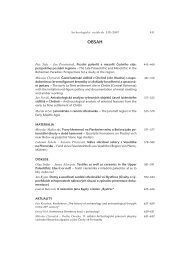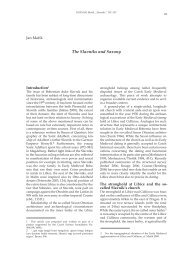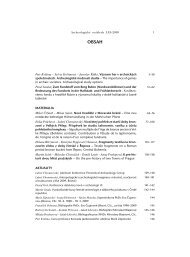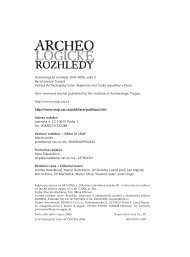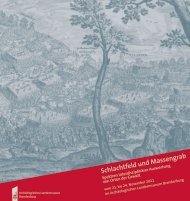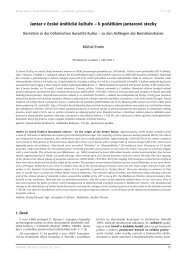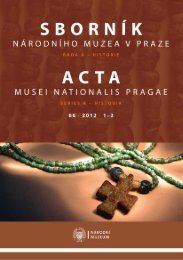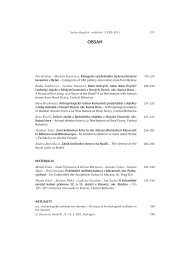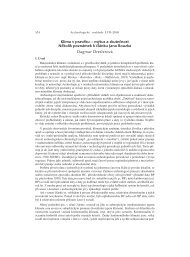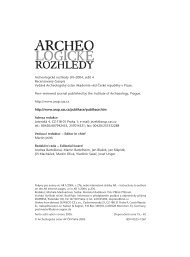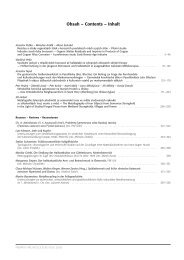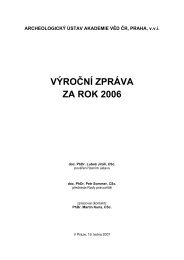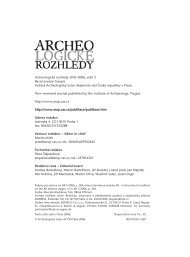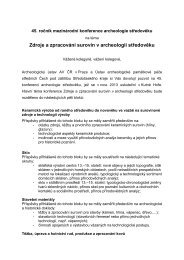Archeologické rozhledy LX–<strong>2008</strong> 327Turek, R. 1976: Libice. Pohřebiště na vnitřním hradisku, Sborník Národního muzea A – Historie 30, 249–316.— 1978: Libice. Hroby na vnitřním hradisku, Sborník Národního muzea A – Historie 32, 1–150.Tylecote, R. F. – Gilmour, B. J. J. 1986: The Metallography of Early Ferdous Edge Tools and Edged Weapons.BAR – British Series 155. Oxford.Valla, T. 1913: Pohřebiště Libické z X–XI století, Památky archaeologické a místopisné 25, 83–84.Zápotocký, M. 1965: Slovanské osídlení na Litoměřicku, Památky archeologické 56, 205–391.Kanín, grave 54 – Research on the grave contentsThe Kanín burial grounds are located on the left bank of the Cidlina River, approximately 500 msoutheast of the early medieval stronghold in Libice (approx. 55 km east of Prague). There, an adultmale was buried in grave 54. The contents of that grave included a sword, a knife, spurs, a woodenbucket with iron fittings, an iron buckle, and a sleeve (fig. 2; 3).The sword that was examined, aY-type according to Petersen (1919, 167–173), and a 13/I accordingto Geibig (1991), is a pattern-welded type sword, with pattern-welded surface panels welded ontothe central iron core. Towards the cutting edges, iron rods are attached to the core and then rods ofsteel form the cutting edges themselves (fig. 10). The steel of the preserved edges contains of about0.3–0.4 % C and does not reveal traces of hardening at the centre of the blade length; on the contrary,a possibility of quenching was evidenced near the point. The sword was a visually impressive andobviously a functional weapon, though its functional quality falls short of that seen in other contemporaryblades entirely of steel or steel-and-iron constructions, provided with a core reinforced withsteel and effectively heat-treated massive cutting edges. Swords of this type were made in the earlysecond half to the end of the 9 th century, and they continued to be used up to the beginning of the11 th century (Geibig 1991, 145–146; Dostál 1966, 67).The knife is ordinary in shape, but has a good-quality and complex serrated blade that bears a wavyweld between the decorative middle strip of phosphoric iron and the cutting edge of quenched steel.New research into Bohemian early mediaeval knife-making indicates that this was a relatively widespreadand popular type of luxury blade in the 10 th –13 th centuries. Knives with similarly designedblades have been found among the contents of wealthier graves and even in rural settlements.The spurs, with tin plating, are of a long-prick type (Kavánová 1976, 54–60), which were the predominanttype not just among the finds at the Libice agglomeration, but have also been widely foundat other early mediaeval burial grounds in Bohemia. As in the case of other spurs found in the Kanínburial grounds (Pokorný – Mařík 2006), the spurs from grave 54 were not paired (fig. 5b: 3, 4). Likethe sword, the spurs found in grave 54 can be relatively broadly dated to sometime during theperiod of the duration of the Kanín burial grounds, that is, from the end of the 9 th to the start ofthe 11 th century.All of the items observed among the contents of grave 54 are valuable, luxury products, but,compared to the contents in some of the most noteworthy graves dating from the 9 th and 10 th centuries,they are not among the most supreme items to be found. In the 10 th century, knives with wavy-weldswere much more accessible than pattern-welded knives. The tin plating and the design of the spurs arealso not among the most luxurious types of decoration for a piece of riding equipment. The questionof the prestige attached to the pattern-welded sword is more complicated. In graves with more luxuriouscontents dating from the 9 th and 10 th centuries we find swords that are not pattern-welded types andinstead have steel cutting edges and a core reinforced with steel. Although these types of weapons arenot interesting in terms of their appearance (they mostly had a dark, monotone shade), their strengthqualities are better than those of pattern-welded swords that were entirely or largely made of iron.The main advantage of blades reinforced with steel was the possibility to manufacture blades of moresubtle forms, which in the development of early mediaeval swords most likely represent a more advanceddesign. Therefore, it is possible that the nobility preferred these types of swords, and pattern-weldedblades tended to be more a reminiscence of the most prestigious weapons from earlier periods.
328HO·EK – MA¤ÍK – ·ILHOVÁ: Kanín, hrob 54 – prÛzkum hrobové v˘bavyFinally, when we inquire into the social standing of the persons in the graves, in addition to theexpensive and prestigious contents, it is necessary to take into account the overall character of theburial grounds and their position within the Libice agglomeration. A comparison of the “expensiveness”of the inventories of the individual graves of two contemporary burial grounds – one in theinner bailey in Libice, and the other outside the fortified area of the stronghold in Kanín – showed thatin terms of the number of “luxury” items the two positions are comparable (Mařík 2005). On theother hand, there is a difference with regard to the presence of ceramic vessels and pails among thecontents of the grave, as they are not found in the inner stronghold grounds. Another difference relatesto the unusual and, at times, almost irreverent way in which the deceased are laid out (on the stomach,on the side, etc.). There are twenty cases of this in Kanín, while in the Libice inner bailey it is found inonly one grave. However, the most significant difference lies in the very position of the burial grounds.Given that space for the vast majority of graves was set aside outside the fortified grounds, the locatingof graves in a prominent part of the inner stronghold grounds must be seen, regardless of the gravecontents, as evidence of high social status. The costly contents buried with the male in grave 54 inKanín is an indicator of the important position he occupied in his society, but the fact that his graveis located on the opposite bank of the Cidlina River in the midst of people who were more or lesstossed into their grave, rather than buried properly, suggests that he was not up on the upper rungsof the social ladder.English by Stephan von PohlJIŘÍ HOŠEK, <strong>Archeologický</strong> <strong>ústav</strong> <strong>AV</strong> <strong>ČR</strong>, Praha, v.v.i., Letenská 4, CZ-118 01 Praha 1; hosek@arup.cas.czJAN MAŘÍK, <strong>Archeologický</strong> <strong>ústav</strong> <strong>AV</strong> <strong>ČR</strong>, Praha, v.v.i., Letenská 4, CZ-118 01 Praha 1; marik@arup.cas.cz
- Page 1 and 2:
Archeologické rozhledy LX-2008 185
- Page 3 and 4:
187-228Archeologické rozhledy LX-2
- Page 5 and 6:
Archeologické rozhledy LX-2008 189
- Page 7 and 8:
Archeologické rozhledy LX-2008 191
- Page 9 and 10:
Archeologické rozhledy LX-2008 193
- Page 11 and 12:
Archeologické rozhledy LX-2008 195
- Page 13 and 14:
Archeologické rozhledy LX-2008 197
- Page 15 and 16:
Archeologické rozhledy LX-2008 199
- Page 17 and 18:
Archeologické rozhledy LX-2008 201
- Page 19 and 20:
Archeologické rozhledy LX-2008 203
- Page 21 and 22:
Archeologické rozhledy LX-2008 205
- Page 23 and 24:
Archeologické rozhledy LX-2008 207
- Page 25 and 26:
Archeologické rozhledy LX-2008 209
- Page 27 and 28:
Archeologické rozhledy LX-2008 211
- Page 29 and 30:
Archeologické rozhledy LX-2008 213
- Page 31 and 32:
Archeologické rozhledy LX-2008 215
- Page 33 and 34:
Archeologické rozhledy LX-2008 217
- Page 35 and 36:
Archeologické rozhledy LX-2008 219
- Page 37 and 38:
Archeologické rozhledy LX-2008 221
- Page 39 and 40:
Archeologické rozhledy LX-2008 223
- Page 41 and 42:
Archeologické rozhledy LX-2008 225
- Page 43 and 44:
Archeologické rozhledy LX-2008 227
- Page 45 and 46:
Obr. 12b. Praha - Malá Strana. Vý
- Page 47 and 48:
230âULÍKOVÁ: Ovoce, kofiení a l
- Page 49 and 50:
232âULÍKOVÁ: Ovoce, kofiení a l
- Page 51 and 52:
234âULÍKOVÁ: Ovoce, kofiení a l
- Page 53 and 54:
236âULÍKOVÁ: Ovoce, kofiení a l
- Page 55 and 56:
238ku, Velké Británii i na Sloven
- Page 57 and 58:
240âULÍKOVÁ: Ovoce, kofiení a l
- Page 59 and 60:
242insititia var. insititia), velko
- Page 61 and 62:
244âULÍKOVÁ: Ovoce, kofiení a l
- Page 63 and 64:
246âULÍKOVÁ: Ovoce, kofiení a l
- Page 65 and 66:
248âULÍKOVÁ: Ovoce, kofiení a l
- Page 67 and 68:
250niger), třezalku tečkovanou (H
- Page 69 and 70:
252âULÍKOVÁ: Ovoce, kofiení a l
- Page 71 and 72:
254âULÍKOVÁ: Ovoce, kofiení a l
- Page 73 and 74:
256âULÍKOVÁ: Ovoce, kofiení a l
- Page 75 and 76:
258âULÍKOVÁ: Ovoce, kofiení a l
- Page 77 and 78:
260âULÍKOVÁ: Ovoce, kofiení a l
- Page 79 and 80:
Polygonum aviculare agg., rdesno pt
- Page 81 and 82:
262DOBE· -VOJTùCHOVSKÁ: ¤ivná
- Page 83 and 84:
264DOBE· -VOJTùCHOVSKÁ: ¤ivná
- Page 85 and 86:
266DOBE· -VOJTùCHOVSKÁ: ¤ivná
- Page 87 and 88:
268DOBE· -VOJTùCHOVSKÁ: ¤ivná
- Page 89 and 90:
270DOBE· -VOJTùCHOVSKÁ: ¤ivná
- Page 91 and 92:
272DOBE· -VOJTùCHOVSKÁ: ¤ivná
- Page 93 and 94:
274DOBE· -VOJTùCHOVSKÁ: ¤ivná
- Page 95 and 96: 276DOBE· -VOJTùCHOVSKÁ: ¤ivná
- Page 97 and 98: 278DOBE· -VOJTùCHOVSKÁ: ¤ivná
- Page 99 and 100: 280DOBE· -VOJTùCHOVSKÁ: ¤ivná
- Page 101 and 102: 282DOBE· -VOJTùCHOVSKÁ: ¤ivná
- Page 103 and 104: 284DOBE· -VOJTùCHOVSKÁ: ¤ivná
- Page 105 and 106: 286DOBE· -VOJTùCHOVSKÁ: ¤ivná
- Page 107 and 108: 288DOBE· -VOJTùCHOVSKÁ: ¤ivná
- Page 109 and 110: 290DOBE· -VOJTùCHOVSKÁ: ¤ivná
- Page 111 and 112: 292DOBE· -VOJTùCHOVSKÁ: ¤ivná
- Page 113 and 114: 294DOBE· -VOJTùCHOVSKÁ: ¤ivná
- Page 115 and 116: 296DOBE· -VOJTùCHOVSKÁ: ¤ivná
- Page 117 and 118: 298Archeologické rozhledy LX-2008
- Page 119 and 120: 300POPELKA: ·típaná industrie z
- Page 121 and 122: 302POPELKA: ·típaná industrie z
- Page 123 and 124: 304POKORN¯: Nález zuhelnatûlého
- Page 125 and 126: 306KYSEL¯: Nálezy obratlovcÛ z e
- Page 127 and 128: 308KYSEL¯: Nálezy obratlovcÛ z e
- Page 129 and 130: 310Archeologické rozhledy LX-2008
- Page 131 and 132: 312HO·EK - MA¤ÍK - ·ILHOVÁ: Ka
- Page 133 and 134: 314HO·EK - MA¤ÍK - ·ILHOVÁ: Ka
- Page 135 and 136: 316HO·EK - MA¤ÍK - ·ILHOVÁ: Ka
- Page 137 and 138: 318HO·EK - MA¤ÍK - ·ILHOVÁ: Ka
- Page 139 and 140: 320HO·EK - MA¤ÍK - ·ILHOVÁ: Ka
- Page 141 and 142: 322HO·EK - MA¤ÍK - ·ILHOVÁ: Ka
- Page 143 and 144: 324HO·EK - MA¤ÍK - ·ILHOVÁ: Ka
- Page 145: 326HO·EK - MA¤ÍK - ·ILHOVÁ: Ka
- Page 149 and 150: 330BRÒÎEK: Souãasná ãeská pal
- Page 151 and 152: 332BRÒÎEK: Souãasná ãeská pal
- Page 153 and 154: 334BRÒÎEK: Souãasná ãeská pal
- Page 155 and 156: 336BRÒÎEK: Souãasná ãeská pal
- Page 157 and 158: 338BRÒÎEK: Souãasná ãeská pal
- Page 159 and 160: 340BRÒÎEK: Souãasná ãeská pal
- Page 161 and 162: 342BRÒÎEK: Souãasná ãeská pal
- Page 163 and 164: 344BRÒÎEK: Souãasná ãeská pal
- Page 165 and 166: 346Aktualityzpůsoby informace o le
- Page 167 and 168: 348AktualityODEŠLA ALENA ŠILHOVÁ
- Page 169 and 170: 350Aktuality22. Monoxyl z Čelákov
- Page 171 and 172: 352AktualityBibliografie PhDr. Petr
- Page 173 and 174: 354Nové publikaceperiodický zdroj
- Page 175 and 176: 356Nové publikaceJiž sama skladba
- Page 177 and 178: 358Nové publikaceMarkus C. Blaich:
- Page 179 and 180: 360Nové publikaceSiegmund, F. 1998
- Page 181 and 182: 362Nové publikaceovšem usnadňova
- Page 183 and 184: 364Nové publikacepozornost věnova
- Page 185 and 186: 366Nové publikaceMartin Oliva: Gra
- Page 187 and 188: 368Nové publikacetakže ojediněl
- Page 189 and 190: 370Nové publikaceliv již dalšíc
- Page 191 and 192: 372Nové publikacevých vrstev Korm
- Page 193 and 194: 374Nové publikaceců s moderními
- Page 195 and 196: 376Nové publikacez mohyly 1) šlo
- Page 197 and 198:
378Nové publikaceLiteraturaDąbrow
- Page 199:
380Anthony Harding et. al.: VELIM -



